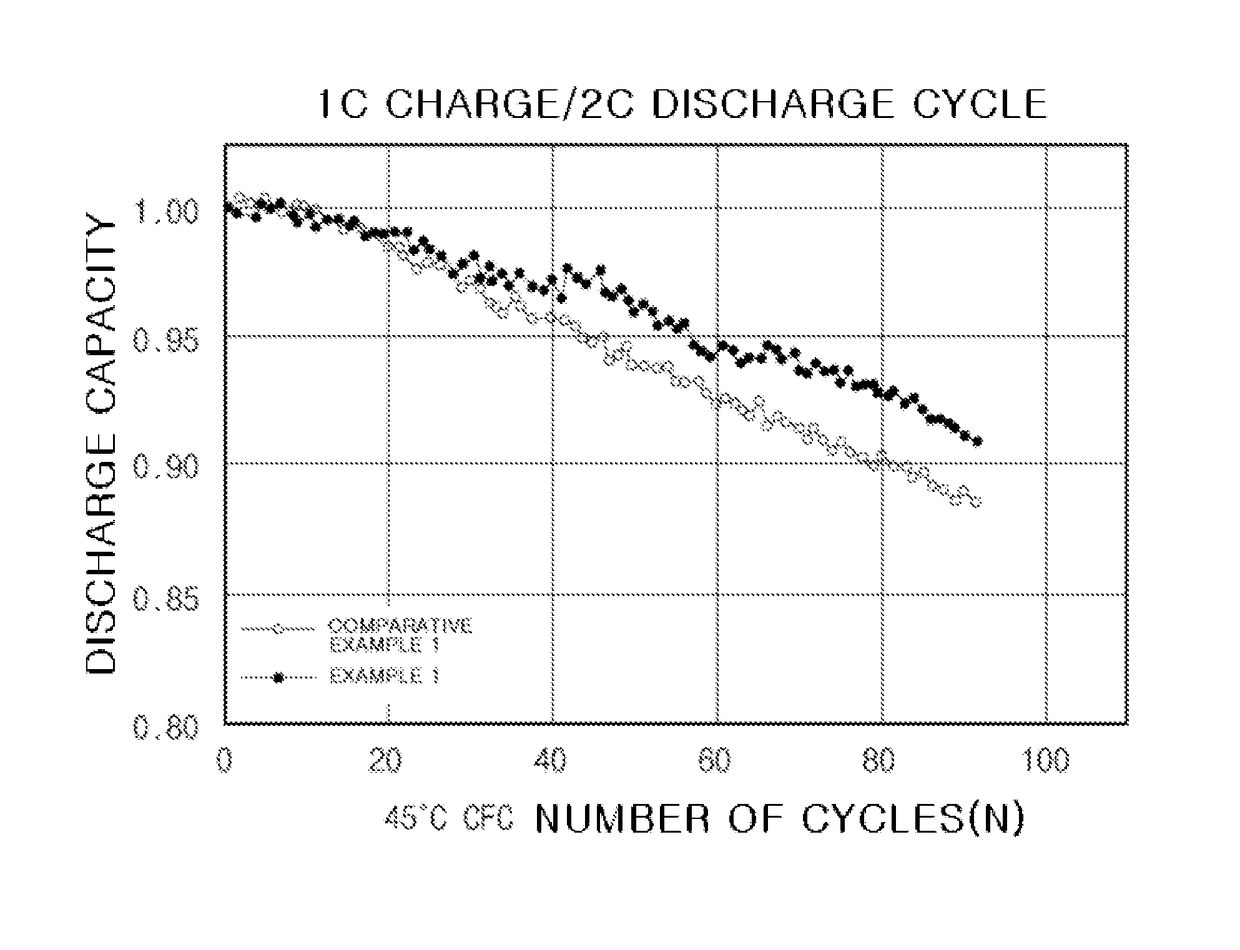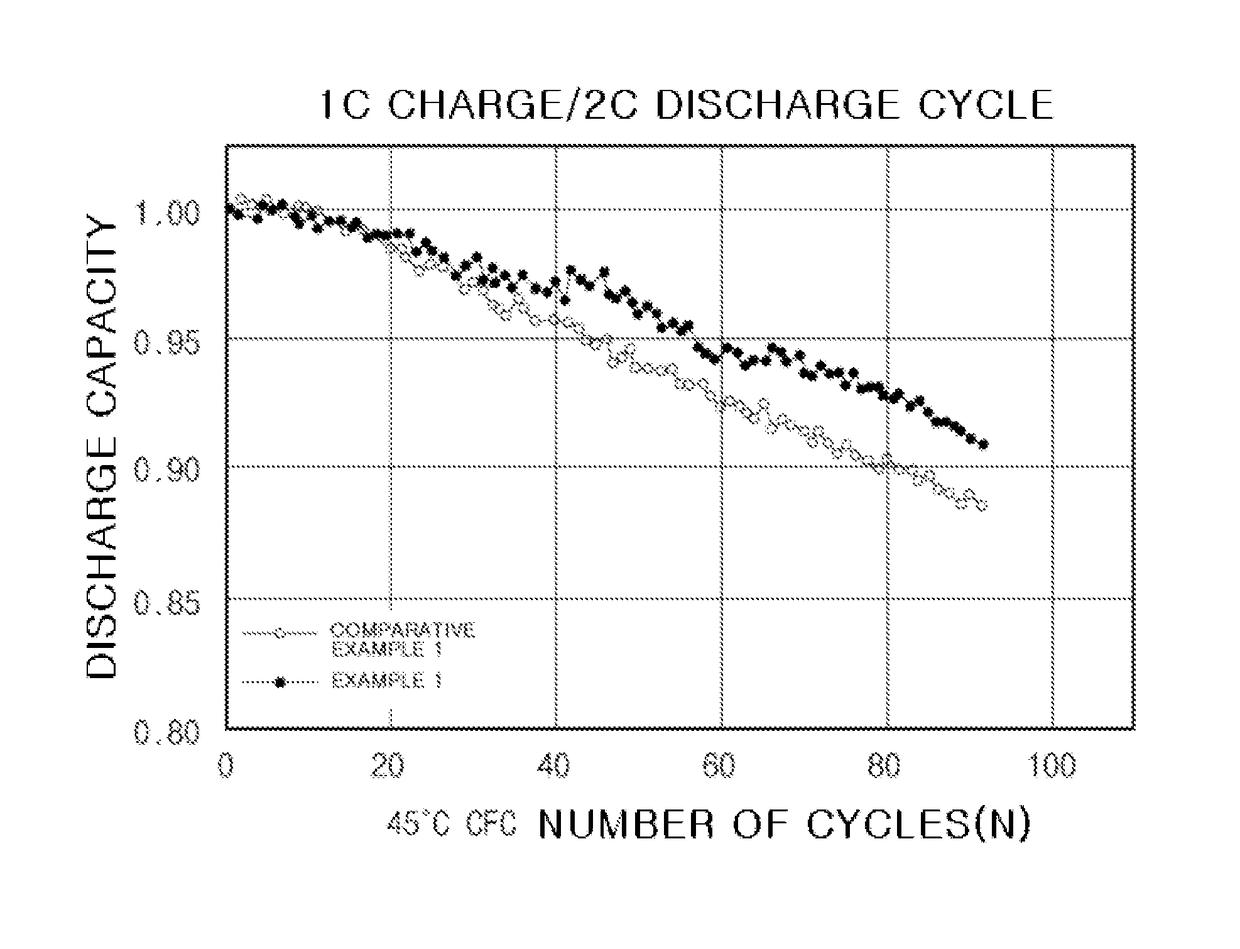Cathode active material composition and lithium secondary battery including the same
a lithium secondary battery and active material technology, applied in the direction of cell electrodes, electrical equipment, cell components, etc., can solve the problems of low capacity, relatively high cost, and low efficiency of lithium secondary batteries, and achieve excellent conductivity, high capacity, and improve conductivity
- Summary
- Abstract
- Description
- Claims
- Application Information
AI Technical Summary
Benefits of technology
Problems solved by technology
Method used
Image
Examples
example 1
[0043]Cathode Active Material Composition Preparation
[0044]A cathode active material composition was prepared by mixing 90.6 wt % of 0.1Li2MnO3.0.9LiNi0.33Co0.33Mn0.33O2 as a cathode active material, 4.4 wt % of carbon black as a conductive agent, 4.1 wt % of polyvinylidene fluoride as a binder, and 0.9 wt % of PEDOT:PSS as a conductive polymer material in an N-methylpyrrolidone (NMP) solvent.
[0045]Cathode Preparation
[0046]An about 20 μm thick Al thin film, as a cathode current collector, was coated with the cathode active material composition and dried. Then, a cathode was prepared by roll-pressing the dried current collector.
[0047]Anode Preparation
[0048]An anode mixture slurry was prepare by adding 96 wt % of carbon powder as an anode active material, 3 wt % of polyvinylidene fluoride (PVdF) as a binder, and 1 wt % of carbon black as a conductive agent to NMP as a solvent. An about 10 μm thick copper (Cu) thin film, as an anode current collector, was coated with the anode mixture ...
experimental example
[0053]
[0054]The lithium secondary batteries (battery capacity: 3.4 mAh) prepared in Example 1 and Comparative Example 1 were charged at a constant current (CC) of 1 C to a voltage of 4.35 V at 45° C., and thereafter, charge in the first cycle was performed by charging the lithium secondary batteries at a constant voltage (CV) of 4.35 V to a current of 0.17 mAh. After the batteries were left standing for 10 minutes, discharge capacities in the first cycle were measured by discharging the batteries at a constant current of 2 C to a voltage of 2.5 V. Subsequently, with respect to each battery of Example 1 and Comparative Example 1, the charge and discharge were repeated 90 cycles to measure discharge capacity for each cycle. The results thereof are presented in FIG. 1.
[0055]As illustrated in FIG. 1, Example 1 including the conductive polymer material of the present invention exhibited better discharge characteristics than Comparative Example 1, in which the conductive polymer material ...
PUM
| Property | Measurement | Unit |
|---|---|---|
| charge voltage | aaaaa | aaaaa |
| temperature | aaaaa | aaaaa |
| conductivity | aaaaa | aaaaa |
Abstract
Description
Claims
Application Information
 Login to View More
Login to View More - R&D
- Intellectual Property
- Life Sciences
- Materials
- Tech Scout
- Unparalleled Data Quality
- Higher Quality Content
- 60% Fewer Hallucinations
Browse by: Latest US Patents, China's latest patents, Technical Efficacy Thesaurus, Application Domain, Technology Topic, Popular Technical Reports.
© 2025 PatSnap. All rights reserved.Legal|Privacy policy|Modern Slavery Act Transparency Statement|Sitemap|About US| Contact US: help@patsnap.com


